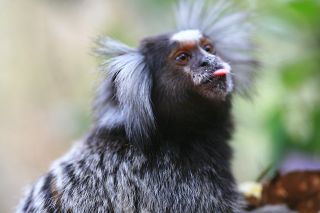Understanding Twins
Marmosets Take Turns Watching for Danger
Flexible vigilance behaviors suggest sensitivity to the needs of others.
Posted January 24, 2023 Reviewed by Abigail Fagan
Key points
- Marmosets in captivity increased vigilance when their pair mate fed and thus could not be vigilant themselves.
- This resulted in a turn-taking pattern of feeding and being vigilant within pairs of marmosets.
- This adds to the evidence that marmosets are sensitive to others' needs and vulnerabilities and can adjust their behavior accordingly.

Marmosets and other small, tree-dwelling monkeys must be vigilant to survive in the wild. After all, predators ranging from snakes to raptors to cats want to make a meal of them. Marmosets maintain high levels of vigilance even in captivity, where they often react to unfamiliar humans or birds of prey spied through a glass roof with warning calls and other antipredator behaviors.
Recently, researchers from the University of Zurich in Switzerland noticed a particular vigilance behavior in a group of captive marmosets: The monkeys appeared to take turns being vigilant and feeding.
“The morning food is given in opaque bowls and consists of a vitamin enriched porridge,” explains Rahel Brügger, lead author of a new study of the behavior. “Marmosets need to lick the food out of the bowl in a head-down position and thus cannot observe their surroundings simultaneously.
“Caretakers and researchers working in the lab reported observations of marmosets appearing to seldom feed together both heads-down but rather take turns.”
To investigate, Brügger and colleagues analyzed video of the fast-moving primates during morning porridge time. The study animals consisted of 12 pair-housed marmosets and one family group with their infant twins.
To exclude the possibility that turn-taking was driven by a lack of space to feed simultaneously, the researchers systematically varied the number of feeding bowls provided. They also varied the location of the morning feeding sessions between the inside enclosures, where the monkeys are typically fed, and the outdoor enclosures, where marmosets may feel more vulnerable to predators.
Turn-Taking Confirmed
Brügger says that the biggest predictor of individual vigilance and feeding time was the presence of young infants in the group, where marmosets with young infants were more vigilant and fed less than those without.
In addition, the researchers found that marmosets fed less in their outdoor enclosure than when fed indoors — perhaps indicating that the outdoor location is perceived as more dangerous by the animals.

But Brügger says the most interesting result was that marmosets’ vigilance appears to be flexibly adapted to the risk level of their pair mate.
“We found that they took into account if the other monkey was feeding and increased their own vigilance levels during these times,” she says. “This then led to a turn-taking pattern of vigilance and feeding.”
Importantly, the increase in vigilance occurred whether there were one or two bowls of porridge available to the pair. The researchers say their overall results suggest that marmosets show “true, prosocial coordination of vigilance.”
Monkey Mental Abilities
This coordination of vigilance may stem from a sensitivity to the vulnerability of others, which marmosets have demonstrated in other contexts. For instance, marmosets share more when food is scarce and harder to access. They also take into account the number of other group members around with whom to potentially share food; when there are fewer potential sharing partners, they step up and share more themselves.
“These cases seem to show that marmosets’ prosocial behaviors are under some degree of voluntary control,” says Brügger.

Brügger would like to see these findings replicated in a larger group. She is also involved in an ongoing project studying the vigilance of adult golden lion tamarins (a relative of the marmoset) during infant play. For research like this, Brügger says, developments in computer vision techniques may allow an even more detailed analysis of how animals organize vigilance at the group level.
Such studies could help us get at what other animals understand about the risk levels of others and how close this understanding is to sophisticated cognitive abilities related to theory of mind (the ability to understand other people’s thoughts, emotions, and perspectives).
According to Brügger, this study shows that “even behaviors that seem to be very basic and maybe not that interesting at first glance” — like eating morning porridge — “can offer important insights into questions relevant for cognitive evolution.”
References
R.K. Brügger, E.P. Willems, and J.M. Burkart. Looking out for each other: coordination and turn taking in common marmoset vigilance. Animal Behaviour, 2022. Doi: 10.1016/j.anbehav.2022.11.007.


